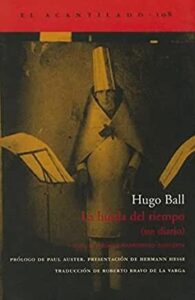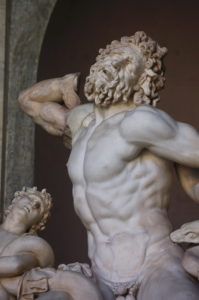Political Theology or Theological Politics? Hugo Ball, Early Christian Hagiography, and a New Vision for Society
by Sebastian P. Klinger
 A contribution to modernist studies and the history of political ideas, this article examines the unlikely intellectual dialogue between Carl Schmitt (1888–1985) and the former Dadaist Hugo Ball (1886–1927), a dialogue that frames the formative scene of politico-theological discourse in the twentieth century. Based on close readings of Ball’s aesthetic, intellectual, and philosophical exchanges with Schmitt, the essay offers insights into the peculiar case of a Catholic intervention into political theology.
A contribution to modernist studies and the history of political ideas, this article examines the unlikely intellectual dialogue between Carl Schmitt (1888–1985) and the former Dadaist Hugo Ball (1886–1927), a dialogue that frames the formative scene of politico-theological discourse in the twentieth century. Based on close readings of Ball’s aesthetic, intellectual, and philosophical exchanges with Schmitt, the essay offers insights into the peculiar case of a Catholic intervention into political theology.
The essay begins:
For more than a century, political philosophers and cultural critics have grappled with the problem of political theology, whose resurgence seems to align with the crises of liberal democracy. Defined in general terms as the reassertion of religion’s place within the putatively secularized public sphere, political theology has sparked extensive scholarly debates in the past two decades, driven by the work of social, legal, and political theorists such as Giorgio Agamben, Claude Lefort, Chantal Mouffe, Paul Kahn, and Eric Santner. At the center of these debates is the conceptual legacy of the right-wing jurist and political philosopher Carl Schmitt (1888–1985). In his influential book Political Theology (1922), Schmitt postulates that “all significant concepts of the modern theory of the state are secularized theological concepts” and links this claim to a theory of sovereignty that invests power with transcendent authority. To finesse and further the understanding of the founding scene of political theology, the present essay rereads Schmitt’s dialogue with the artist Hugo Ball (1886–1927), which paralleled the publication of Political Theology in 1922. Bonding over Catholic values, Ball and Schmitt studied each other’s writings, exchanged letters, met in person, and discussed their book projects. But the elective affinity between the Dadaist-turned-oblate and the prospective “Crown Jurist” of the Third Reich ground to a halt after Ball published the first-ever examination of Schmitt’s thought. The study at hand analyzes how Schmitt and Ball begin from Catholic principles but then move apart as they seek to define political theology.
Ball’s contribution to political theology has been mostly overlooked in the wider scholarly debate for three reasons: the historic encounter of Ball and Schmitt seems unlikely; the texts in which Ball’s critique unfolds are hermetic and difficult to access; and the thrust of his argument points in a direction different from more recent studies on economic-political theology. Today, Ball remains best known for his flamboyant involvement with the Zurich art movement Dada, in particular, for his legendary performance as a “magical bishop”; for his friendships with Walter Benjamin and Ernst Bloch; and for an antiwar activism that expanded into a thorough intellectual critique of German militarism. But in the aftermath of the Great War, the former Dadaist broke with his left-wing past and returned to the Catholicism of his childhood, searching for a form of life that negated the violent turn of Western culture. It was then that he entered into dialogue with Schmitt, whom Ball initially perceived as a new Catholic philosopher, “great and expansive like a scholastic.” Between 1919 and 1925, they discussed what political theology could mean—an urgent question in the face of the historically unprecedented opportunity to rethink Germany’s social order from scratch after the November Revolution of 1918–19 had unseated the emperor and launched the country on its ill-fated and crisis-ridden experiment with parliamentary democracy.
Ball and Schmitt shared many concerns, but their dialogue revealed fundamental divergences on political theology. Near the end of their exchange, Ball noted: “In my experience, reaching an understanding with someone else is a thorny and delicate matter. For this reason one has to write books.” In direct response to the appearance of Schmitt’s seminal Political Theology, Ball published two texts of his own that are entwined with his turbulent exchange with Schmitt. One of these texts bears in an obvious way on the dialogue: Ball’s essay “Carl Schmitt’s Political Theology” (1924) combines a magisterial command of Schmitt’s thought with a subtle but scathing intellectual critique of his interlocutor. It points out the shortcomings of political theology with regard to the nature of the zoon politikon, the concept of politics, and the notion of sovereignty. Concurrently, Ball laid out his own political vision in a strange book entitled Byzantine Christianity: The Lives of Three Saints (1923). This book focuses on the form of life developed by John Climacus, a monk and hermit of the seventh century; Dionysius the Areopagite, a late fifth- to early sixth-century Christian theologian and philosopher; and Saint Simeon Stylites, a fourth-century anchorite. Although Ball’s startling turn to hagiography seems to stand out as a departure from pressing questions of politics, Byzantine Christianity contains, paradoxically, a new vision for German society. Why, though, did Ball choose the genre of hagiography to convey his ideas? In what follows I will argue that these two texts work together as an intervention into political theology.
Approaches to the later work of Ball tend to fall into two camps: that of his “Catholic quietude” and that of a “sacralization of power.” Yet Ball’s association and interaction with Schmitt complicates both of these arguments. My argument differs from the quietude thesis, as it shows that Ball strives to deactivate the distinction between friend and enemy as the “specific political distinction to which political actions and motives can be reduced.” And it differs from the “sacralization-of-power thesis,” as Ball’s theological politics seeks to establish the transcendent law as an “institution” that “can never come into direct relation with the state.” For Ball, the church becomes an institution only in its suspension; what legitimizes it is resistance to a government gone rogue. Basing my argument on close readings of Ball’s Byzantine Christianity and “Carl Schmitt’s Political Theology,” I contend that such theological politics must be conceived as a critique of Schmitt’s thought. If Schmitt legitimizes political authority with a transcendent source, Ball delegitimizes it; if Schmitt glorifies the sovereign, Ball champions the saint; if Schmitt does away with human rights, Ball declares “opposition” to the violation of human rights as “the highest duty.” I develop my argument in two steps: I begin with a discussion of Ball’s political vision in Byzantine Christianity, paying close attention to the aesthetic form of the book and its place in history. I then examine Ball’s “Carl Schmitt’s Political Theology” and bring out his critique of Schmitt. Continue reading …
SEBASTIAN P. KLINGER is a PhD candidate in the Department of German at Princeton University. His research investigates sleep experiments in literature, science, and society, 1899–1929.

 Trying to understand pain tolerances as a symptom of culture already gets us entangled in a second distinction: that between pain experiences and pain expressions. Here we enter upon a field of investigation in which the historian of art feels right at home, since questions surrounding the representation of pain in the visual arts have always been part and parcel of imitative art’s charge to represent psychic states and moral virtues—or their opposites—through coded bodily movements, gestures, and physiognomic signs. But questions of pathetic naturalism only get us so far in explaining why, for example, the famous clenched brow of the Trojan priest Laocoön in the eponymous figure group in Rome, as a physiognomic token of pain, communicated to its beholders a “pain-experience” so different from the one conveyed by its counterpart in the Master of Flémalle’s image of a Crucified Thief. We could rehearse the clichéd contrast between heroic death in pagan tragedy and sacrificial suffering in Christian theology to see that distinct narratives of human suffering and conflict are what drive the transferences between pain experiences, pain representations, and pain perceptions. Would we find that it is the very possibility of narrative that makes pain culturally intelligible in the first place? What’s clear is that the full implications of a culture’s narrative-ideological meanings for pain expression in the visual arts would be lost if we failed to attend to the situated functions of images, the peculiar agency they are granted to enlist the beholder’s effort in realizing their effects and completing their meanings in historically specific situations of use. Something of the logic of that agency can be recovered and measured by the forms of response demanded and structured by the image. We may begin, then, with one kind of image that, in portraying the very response it demands, tells us something about the peculiar way spectacular pain expressions registered in late medieval culture.
Trying to understand pain tolerances as a symptom of culture already gets us entangled in a second distinction: that between pain experiences and pain expressions. Here we enter upon a field of investigation in which the historian of art feels right at home, since questions surrounding the representation of pain in the visual arts have always been part and parcel of imitative art’s charge to represent psychic states and moral virtues—or their opposites—through coded bodily movements, gestures, and physiognomic signs. But questions of pathetic naturalism only get us so far in explaining why, for example, the famous clenched brow of the Trojan priest Laocoön in the eponymous figure group in Rome, as a physiognomic token of pain, communicated to its beholders a “pain-experience” so different from the one conveyed by its counterpart in the Master of Flémalle’s image of a Crucified Thief. We could rehearse the clichéd contrast between heroic death in pagan tragedy and sacrificial suffering in Christian theology to see that distinct narratives of human suffering and conflict are what drive the transferences between pain experiences, pain representations, and pain perceptions. Would we find that it is the very possibility of narrative that makes pain culturally intelligible in the first place? What’s clear is that the full implications of a culture’s narrative-ideological meanings for pain expression in the visual arts would be lost if we failed to attend to the situated functions of images, the peculiar agency they are granted to enlist the beholder’s effort in realizing their effects and completing their meanings in historically specific situations of use. Something of the logic of that agency can be recovered and measured by the forms of response demanded and structured by the image. We may begin, then, with one kind of image that, in portraying the very response it demands, tells us something about the peculiar way spectacular pain expressions registered in late medieval culture. 